Going by the string of 2015 releases from the Oregon based brand, it would appear that the designers, developers and product managers who work on Nike’s running line are subservient to one overriding mandate – that to create more room inside the shoe. Or how else would you explain the Flyknit Lunar 3, Nike Free 5.0/4.0, and the Vomero 10 , all of which now come boxed with a spacious than before upper?
That clarion call to action is also supported by another comforting trend, which is that Nike is warming up to offering widths again outside of its iD program. We use the word ‘again’, because there was a time (around 2006-08) when Nike used to offer 4E in some of their popular models. Slowly that period passed, and the options of additional widths became as rare as a Sasquatch sighting. Which was like never.
So the invigorated, two-pronged attack on getting the fit part right will do the footwear giant a great deal of good in the long run. One size does not fit all, and there’s a good reason why a standard men’s Brannock device has a slider which can measure multiple widths – a sobering reminder that while the running community might be undivided in their common love for shoes, that isn’t necessarily the case with foot anatomy.
The 2015 Free 3.0 Flyknit has got that ‘create more room inside’ memo too, apparently. And while there are no widths available on any of the running Free versions (except for NikeiD), all of them have undergone a fit upgrade. The 2015 Free 5.0 is much more comfortable than before, whitewashing some of its earlier design flaws.
The Free 4.0 Flyknit has a far more relaxed upper fit than last year, and the Free 3.0 Flyknit – the textile and foam hero of this review – has obviously been to the same nip and tuck surgeon, emerging with increased interior space over previous year.
Like the rest of its flexible midsole brethren released in 2015, the Free 3.0 Flyknit sports the same midsole bestowed by the process of the 2014 Free makeover; a shift from the angular criss-cross of flex grooves to hexagonal foam pillars and cuts.
Much akin to the Free 4.0 or the Flyknit Lunar 3, the upper refresh causes that ‘whole foot-changing-its-position-over-the-midsole’ thing. But it is of a far lesser magnitude and hence does not result in a noticeable shift of cushioning characteristics. So in short, the 2015 Free 3.0 rides exactly the same as its previous self. The upper change(s) wields its influence over fit behavior only.
Thus the ride report is going to sound similar in some parts to our 2014 review, and we’ll talk about that in the second half of the review. We’ve also had the 2014 Free 3.0 Flyknit for a while now, so we’re armed with additional insights on the ride quality compared to what we put out last August.
The entirety of newness is limited within the the confines 3.0’s one piece knit upper; while looking visually similar to the 2014 design, there are a number of updates which result in substantial fit differences.
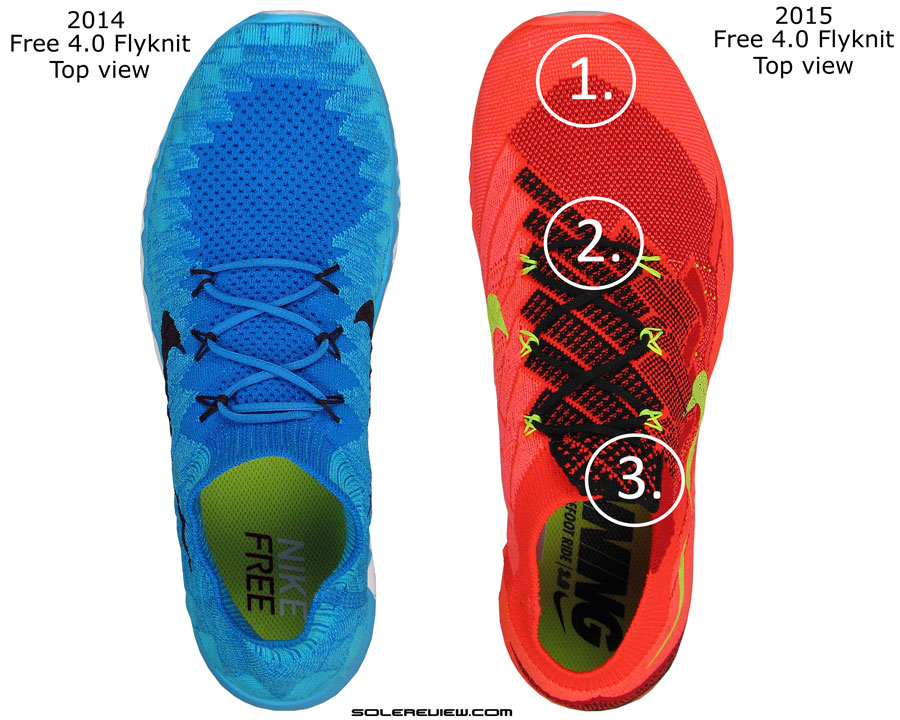
1) Shallow toe bumper like the previous 3.0 2) Lacing position moves forward 3) Changed collar design+bigger opening.
If you found the 2014 3.0 FK to be tighter than what you wanted it to be, and conversely was expecting the latest Free 3.0 to free up more space inside, then you’ll likely end up happy. There are a couple of factors which work together to end up with giving the 3.0 upper a much more liberal feel.
The first part boils down to being a matter of material basics; the fact that the new Free 3.0 comes with a textile upper made of a lighter weave than before, which (predictably) lowers the constrictive sensation.
The second part concerns how certain areas of the shoe have been redesigned, with the intent of making the upper apply less pressure over the foot. Essentially, the Free 3.0 goes the 4.0 way – the new fit is more lenient than the past, by which we mean that the once very stretchy Flyknit becomes less stretchy.
Another way to look at this is that the 2014 Free 3.0 was much smaller when boxed than on the foot, which implied that the shoe needed to expand a great deal to accommodate the larger volume of the foot.
In comparison, the 2015 Free 3.0 starts by being closer to the actual foot size, so there is a lesser degree of Flyknit expansion when you slip it over your foot. In other words, the new upper simply has more volume in its unworn state, bringing down the degree of stretch it has to the undergo.
This makes the new Free 3.0 a higher -make it much higher – shoe. And none of this insight is based on touchy-feely observation; the difference can be measured in actual, metric terms.
Take the point where the forefoot and midfoot meet. If you ran a tape over the shoe’s girth, then the 2015 Free 3.0’s circumference is greater by around 12 mm over the 2014 edition.
Run a similar exercise on the midfoot-rearfoot area – which happens to be the highest point of the shoe – and that difference is a whopping 20 mm+. The 2015 3.0 also packs more weight (11 grams/nearly half an ounce) relative to its previous design, and since the midsole hasn’t changed, the apparent increase of upper material is the logical reason.
All facts and figures now considered, how does that impact the quality of upper fit? The Free 4.0 Flyknit had a toe bumper change, and does the 3.0 go the same way? Let’s do a quick recce of the area.
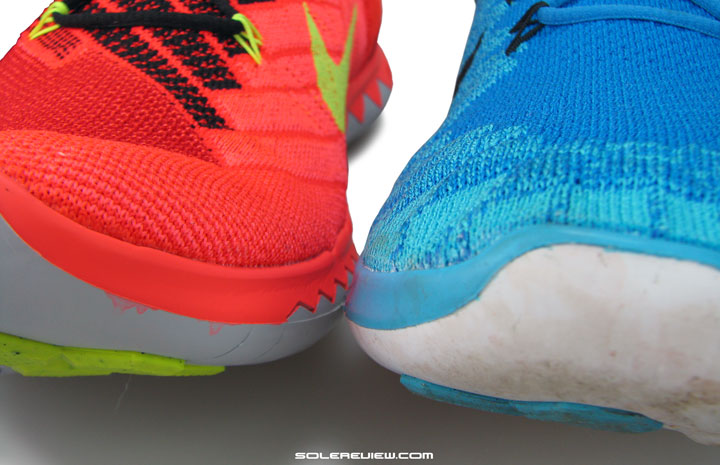
The snap fitting toe box stays more or less the same vs. previous edition. (Right: 2014 3.0 v1, Left: 2015 3.0 V2)
The toe box height stays more or less the same across the 2014 and 2015 Free 3.0. Because there’s no raised toe bumper treatment like the 4.0, so the height stays what it is – shallow. Yet when it comes to actual space ahead of the toes, the new 3.0 Flyknit pushes the foot further in.
And that’s not because of how the toe area is designed, but due to a seemingly unrelated reason – the heel collar. Read up our section (later in the review) on the upper heel redesign to see a detailed change description. The other way to view this is that a half-upsize might be required for some people, and like any running shoe purchase, get yourself fitted first to see how much the change impacts you (or not) in terms of sizing.
But as far as fit pressure is concerned, the toe box is only portion which has a lot in common with the 2014 model, because rest of the 2015’s interior dwellings loses most of the previously felt compactness.
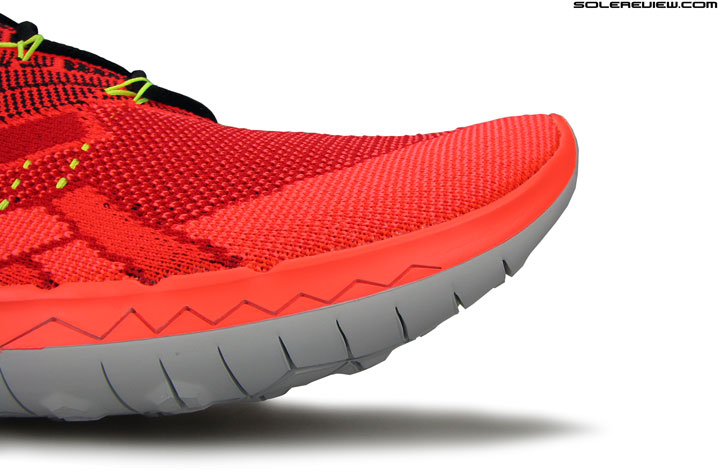
Less stretch in the revised Flyknit construction leads to a lower midsole pull. Result? Lower toe spring vs. 2014.
Nodding to our girth measurement findings, 2015 ushers in a forefoot fit update, which happens to end up providing more splay room. The small toe and the base of big toe don’t feel as hemmed in; the diluted elasticity of the Flyknit even goes as far as affecting the toe spring.
If you place the 2014 and 2015 Free 3.0 front ends toe to toe, you will see that the 2014 shoe had a higher lift near the toe. The 2015 3.0 points up for sure, but not as skyhigh as its previous avatar.
The revised toe spring isn’t the midsole design’s doing, because both models share an identical component. Rather, this indirect measure is a sign of how much lenient the Flyknit’s stretch character has become this year – it has a lower tendency to pull up the midsole tip, and this also suggests that the forefoot is more relaxed.
And relaxed it is -the forefoot fit achieves this feat even with the first row of lacing inching forward by a full millimeter. Usually, this would have the forefoot ceiling sit lower on the foot and make that section snugger, but this is clearly an exception.
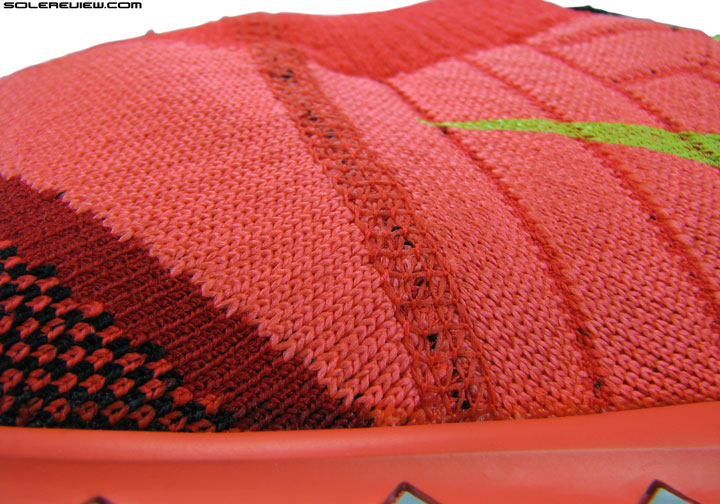
The Free 3.0 features an unique true bootie design, with only a solitary seam making the single piece upper whole.
The change in lacing position is part of the slew of changes which the midfoot goes through. Three columns of Flywire cords perform the supplementary lacing duties, though the true slip-on bootie construction of the Nike Free 3.0 diminishes the important of external lacing.
Can you do completely without the lacing? On the 2014 Free 3.0, our heads would nodded affirmatively in agreement, but on the latest 3.0, Flywire does influence the lockdown, a quality which you will miss if you decided to go running without cinching them up.
Lacing is more spread over the foot this time around. The 1 mm of forward lacing we just underscored is due to increased spacing between the rows, which also plays its part in reducing pressure around the midfoot. But it doesn’t have so much of an impact in making the fit relaxed as does the increase in actual girth; after all, Flywire was more effective on a smaller, compressive upper of the 2014 Nike Free 3.0 Flyknit than it is here.
Come to the rear of the 2015 Free 3.0 Flyknit, and that’s the portion with the major update, with far reaching consequences on fit. Because the collar area is such a critical component of shoe’s fit; the rest of the upper might wrap around the foot nicely, but if the heel slips, the shoe’s pretty much dead in the water.
Like on the 4.0 Flyknit, the ribbed elastic band has been thinned down, which helps in bring down the snap level around the skin. Height has been substantially increased on either sides – Nike’s way of compensating for the loss in Flyknit tightness.
By how much exactly? Approximately 5 mm on the medial (inner) side and by over a mm on the outer upper. That’s a lot.
This has the collar edges riding up on the ankle bone more than the 2014 Free 3.0 did; we found it a bit intrusive but not to the point of being uncomfortable.
However, the crucial design feature at play here is the overlapping flap – near the point where the tongue flap would normally be on any other shoe.
See that? This is the footwear equivalent of a Chinese collar, with the previously unbroken band of elastic collar now split at this point. This helps accomplish a few outcomes with respect to fit. The obvious one is an easier entry into the shoe, as the split collar allows a greater freedom of movement.
And this innocuous looking flap has a far greater influence on quality of the collar fit and grip more than both the increased height and collar band combined. There is a significant reduction of pressure right at the instep, and overall the collar has a larger opening this time around, keeping in mind how pucker-faced the 2014 Free 3.0 collar was.
The other non-obvious effect is the manner in which this construction allows the foot to re-position itself more towards the front, and crawling into toe space. The 2014 3.0 in contrast, had a super tight instep band which made sure the foot stayed put. This is the reason why the 2014 Free 3.0 Flyknit feels slightly smaller than the version before it.
There are added positives like a larger lining on the back of the inside heel. This isn’t visible externally, but you see it covering the Flyknit upper inside. The overlay is a soft, felt like lining which was part of the 2014 Free 3.0 design too, but only this time it covers a larger expanse.
So yes, smoothness improves here, and that sentiment applies to inside the midfoot too, as lower compression levels make the panels smoother.
Midfoot panels are flatter (like the Free 4.0) and even the Flywire cords burrowing through the mesh tunnels don’t feel as raised inside compared to the previous design. If you ran your fingertips over the inner midfoot surface of the 2014 Free, then you would have sensed pronounced ribbing in the area where the Flywire threads passed through. Repeat the same experiment this time around, and your fingertips tend to slide relatively smoother than before.
So basically that was the fit summary of the 2015 Free 3.0 Flyknit. Much looser upper than before, more of a regular sock like feeling instead of a compression sock. And what do we think of this change?
The way we see it, the fit improvement isn’t as impressive as what we witnessed on the Free 4.0 Flyknit. Sure, the 3.0 upper is now more relaxed, which is a good thing, but it misses that vital element of evenness. Like how the shallow toe bumper with its heightened snugness and the heel’s easygoing nature are sensory contrasts within the whole picture. Our point is that the shoe should feel completely balanced in its fit delivery, and this is where the Free 3.0 plot meanders into a territory of inconsistency.
More importantly, we feel that the Free 3.0 is way more civil than it should have been, particularly in places like the midfoot and heel. An easier way to explain this is that if the 2014 Free 3.0 was a level 10 on the compression scale, the 2015 Free 3.0 sits on a mellow scale of 5. It would have been better if the fit was between a 10 and 5, around 7 if you will.
Because while the Free 3.0 fits great with a pair of running socks, it struggles to find its balance when worn without. A lot of runners will like to wear the Free Flyknit barefoot, even if occasionally so, and when one does, the fit quality does not inspire confidence. Kind of feels a bit loose, especially around the collar. It’s all sunshine and lemonade when running on a flat road, but throw in some gradient as a variable, and the foot suddenly acquires a new tendency to move around.
And like what we said about the Free 4.0, a looser top leads to a lack of lock-down, and thus eroding stability levels of the shoe. Doesn’t the Flywire help?
It does, but the cincing comes at the added cost of increased top down pressure. The cords are sheltered in tunnels within the Flyknit structure, with a lesser freedom of movement than the top. So tugging on them just ends up tightening the top and not the sides. Equate this to a pajama or shorts with drawstrings. Yank on the cords, and the pull seems to be concentrated at the front, and not spread evenly around the waist.
And the fact that the Free 3.0 Flyknit midsole is designed differently vs. the 5.0 and 4.0 also has a say in overall stability levels – more on that in a bit.
Side swoosh logos are aesthetically enhanced by the use of what appears to be high visibility screen ink. On this reviewed color, the logo was a florescent neon green, the kind of color you see come out of the felt tip of a highlighter pen.
Certainly not reflective, but that could have been easily achieved to some extent, like how it was done on the Flyknit Lunar 3. The Free 3.0 Flyknit isn’t cheap after all; $140 is unmistakably steep for what the shoe looks and feels like. So night time visibility should be a part of the deal, specially when it is no longer a technological handicap with respect to its execution on Flyknit uppers.
Though the entire package of midsole/insole/lasting and outsole rubber is from the 2014 model with no changes at all, it will be well worth our (and your) while and talk a bit about the ride. After a year of occasional off-an-on use, we have a slightly different perspective on the 3.0’s bottom design.
As you are already aware, the 3.0 is supposed to be Nike’s most minimal Free, and when you run in them, the impression matches up. It rides firmer than both the Free 5.0 and 4.0, and feels the minimal-est of all.
But is it truly so?
The Nike Free 4.0 and 3.0 are closely matched in ground feel, so let’s take the 5.0 for comparison instead. The outsole footprint might look narrower on the Free 3.0 than the 5.0, but in reality, the span isn’t all that different. Neither does the midsole stack height/thickness look any slimmer than the 5.0.
And some of the available online data corroborates this; runnerswarehouse lists the Free 3.0 forefoot’s stack height as higher than the 5.0. Don’t see any reason to doubt the information, as that very well might be the case. Even Runnersworld’s description of the 3.0 and 5.0’s stack heights reveals similar dimensional differences.
The weight of the Free models is a solid clue. Only a mere 4 grams separates the 5.0 and 4.0, and an equal amount grammage difference between the 4.0 and 3.0. That is barely anything. Oftentimes, 4 grams is the difference between the right and left half pair of the same shoe. We see that all the time when weighing our shoes on the scale.
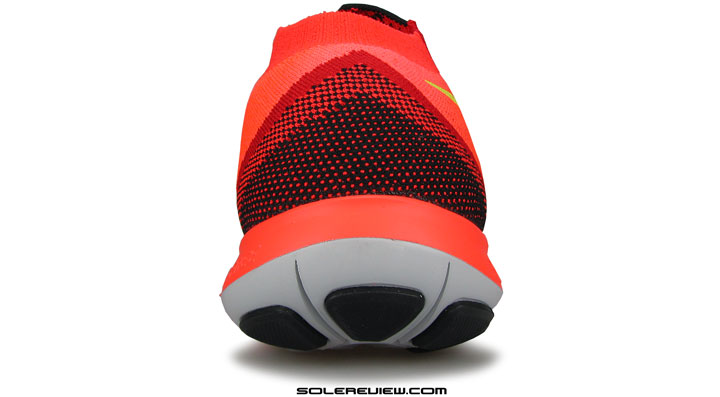
This design has an uncommon ‘360 degree’ rocker design, which translates into a slimmer profile. At least visually speaking.
What sets the 3.0 outsole apart from the 4.0 and 5.0 are its midsole boundaries of exaggerated roundness. This ends with the visual effect of the midsole looking much slimmer than what it really is, and from a performance standpoint, the weight loading stays focused along the center-line.
This means that pressure is focused on a smaller part of the midsole and not widespread like the Free 5.0, which uses the full base of its midsole to its advantage. Ditto for the Free 4.0, and the earlier iterations of the 3.0 platform.
Therefore, the ride quality ends up being firmer purely as a byproduct of the shape, without any substantial change in stack height or foam firmness vs. other Free variants. Ok, there’s a bit of the insole play here too. While both the 5.0 and 3.0 share the same footbed design, the 5.0 uses a softer foam density. As far as the actual midsole EVA foam is concerned, we could not sense any difference in firmness.
Now if we were to explore Nike’s point of view on the 3.0 midsole design, the #1 reason behind the latter’s relative bulk seems to be Flyknit itself. Supposing that the 3.0 midsole had a more spartan (and hence flexible) built, then the entire shoe would have curled up like a ball of yarn, thanks to the elastic upper.
Transition is smooth on the 3.0, as it was on the 5.0 and 4.0. That’s the doing of the single midsole component, and the hexagonal design which makes weight loading feel connected along the shoe length.
There are proven tricks used here, like an angled heel bevel for gradual landings, and a removable sockliner which provides soft-top cushioning.
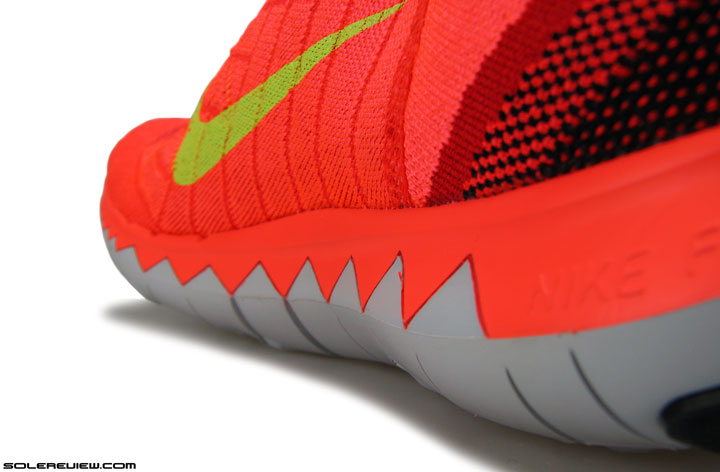
Even the sides have a massive bevel, reducing the actual area of outsole which makes contact with the ground.
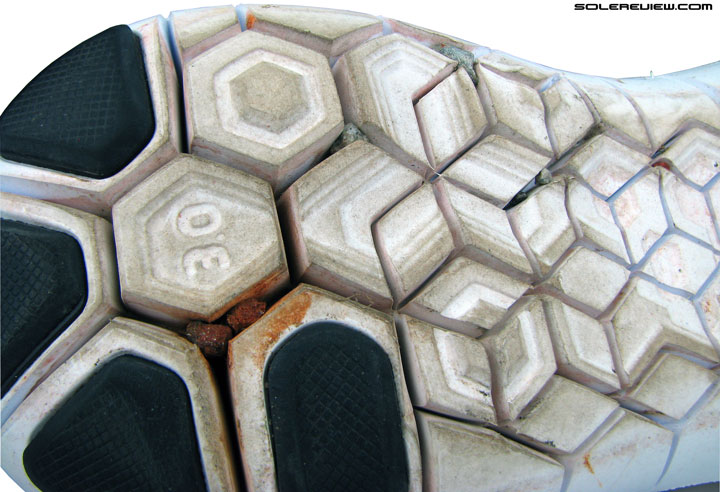
Weight loading gets concentrated into a smaller area. And the space between the flex grooves is like a frat house for road debris.
However, the extremely beveled design of the midsole makes the 3.0 less stable than both the Free 4.0 and 5.0. Structural basics comes into play here; lower the contact area, smaller the foundation on which the foot rests. We’re definitely not saying that the 3.0 is so unstable that it’ll buck you around. It works perfectly well on flat, paved surfaces.
What we’re highlighting is that the Free 3.0 feels less planted than the 5.0, and even the 4.0. And this is more of a heel/rearfoot observation than the forefoot, where there’s enough midsole footprint to go around. In that sense, the earlier Free 3.0 V4/V5 platform had a steady, planted feel to it.
As far as making good running time on the Free 3.0 Flyknit is concerned, there’s absolutely no problem at all. The firmer feel of the shoe works for faster runs, and forefoot transition/push-off is no more work than the 4.0 or 5.0; remember that the 3.0 isn’t as minimal as it once used to be.
The cushioning is enough to take the 3.0 out on longer runs, and if you’re used to flats, then even a marathon. We wouldn’t encourage track use, as some might find their foot sliding off the heel midsole edge when coming in hot through the bend.
As a whole, the new Free 3.0 Flyknit is a mixed bag. It isn’t the all out example of minimalism it sets out to be (which was the whole point, wasn’t it?), and while there are improvements on the upper fit and feel over last year, there are rough design edges in need of some polishing.
It is also priced at $140 retail, so when faced with the conundrum of which Free model to buy, the 4.0 and 5.0 suddenly turn out to be far more appealing prospects. If the Flyknit upper appeals to you, then you should get yourself the superlative 4.0.
(Disclaimer: For this review, Solereview bought the shoe at full US retail price.)
Looking to upgrade your older Nike Free 3.0 Flyknit to the latest version, but not sure how the 2015 model compares? We can help here. The following infographic is a ready-reckoner for what changes you might expect in the new model vs. old. To make this more fun, we’ve put in a system of percentage match, which calculates a weighted average for a set of attributes.
A higher or lower match percentage is neither good or bad. The % number just tells you how similar or distanced the new shoe is from the previous version. Total match % is a result of weighted averages.

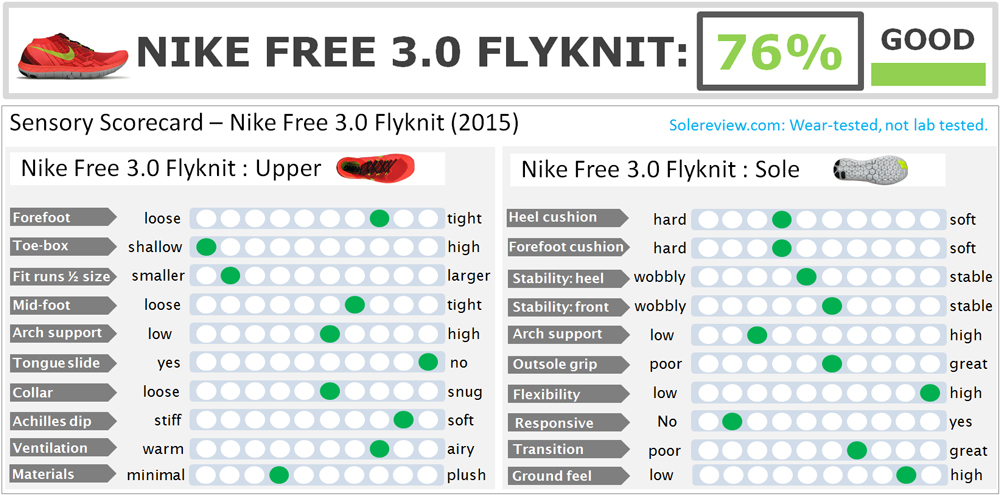
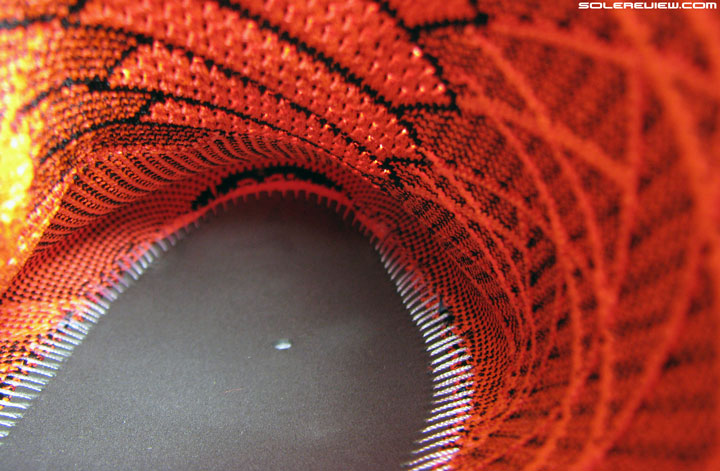
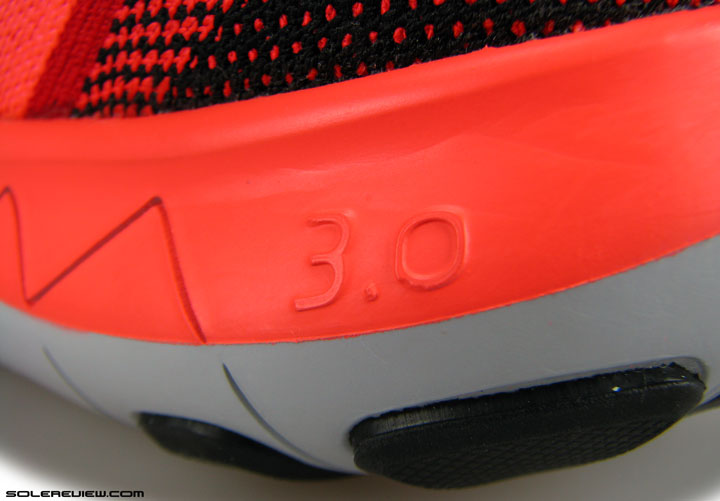
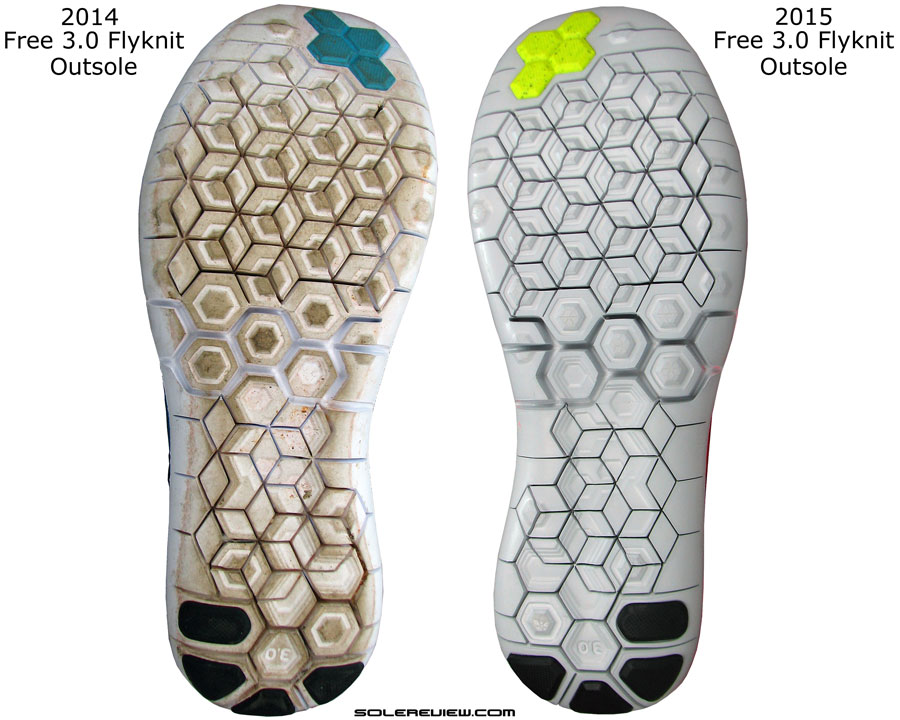
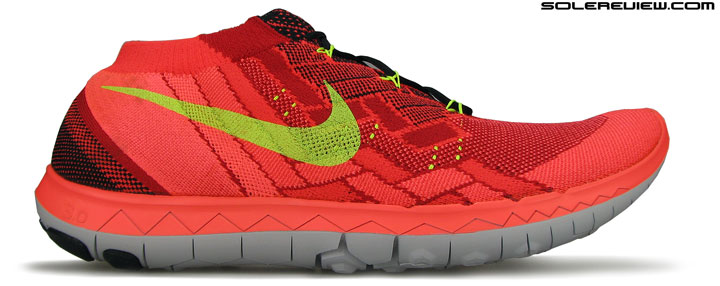
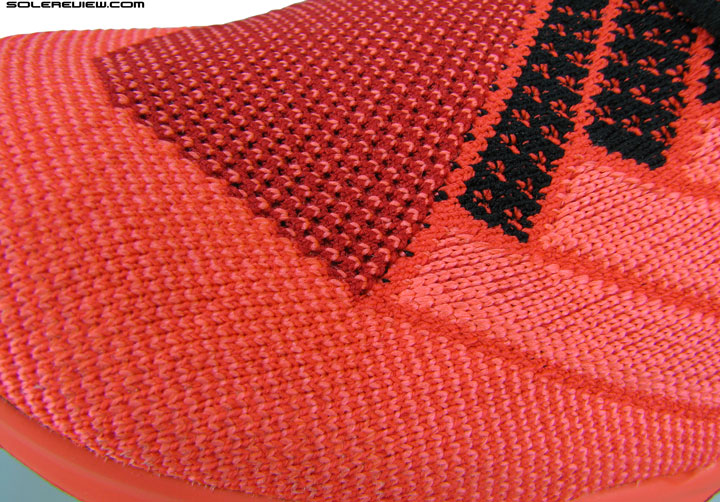
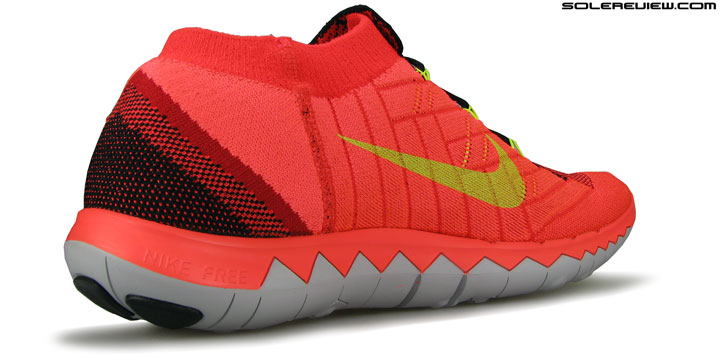
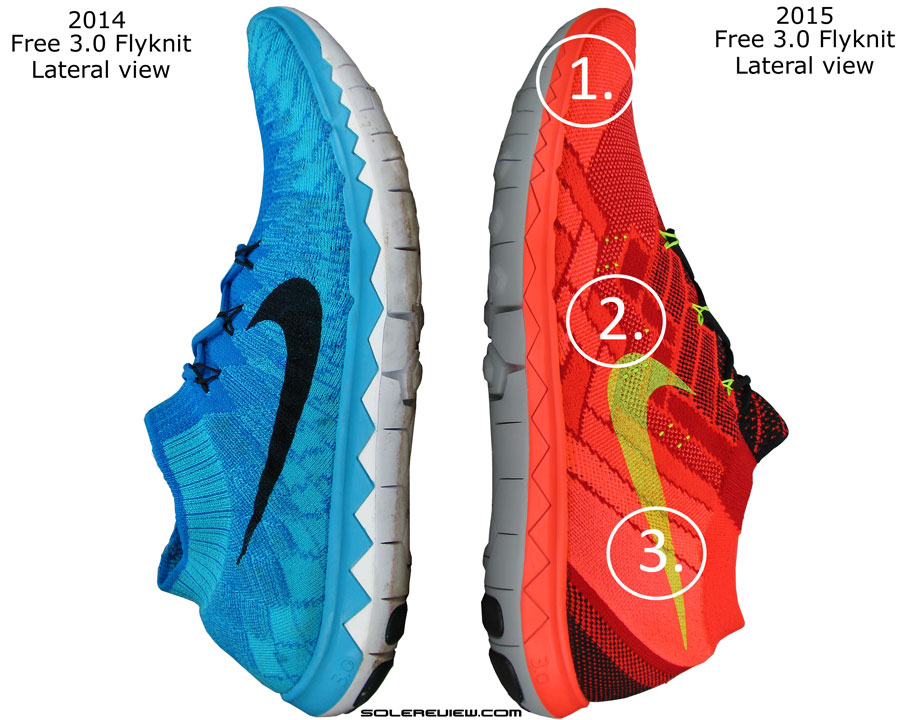
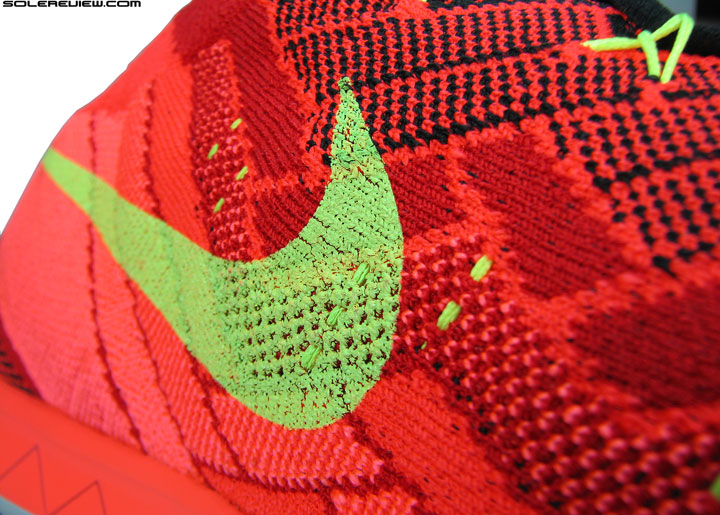
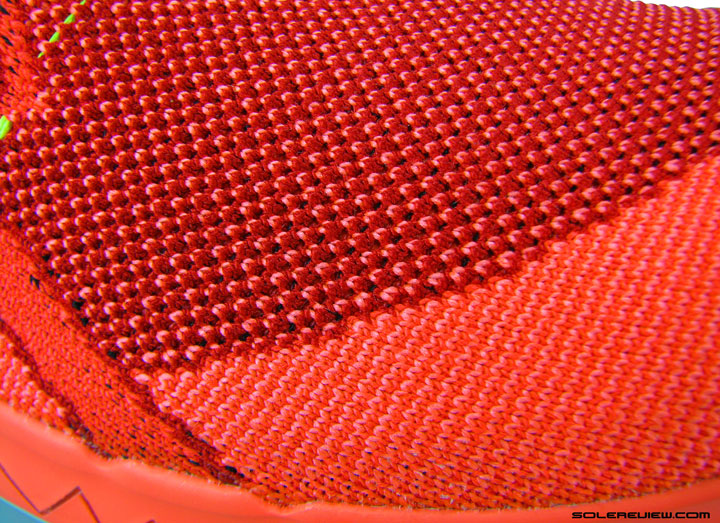
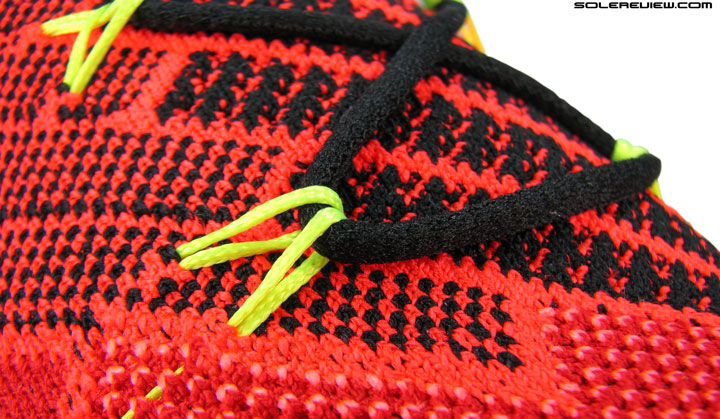
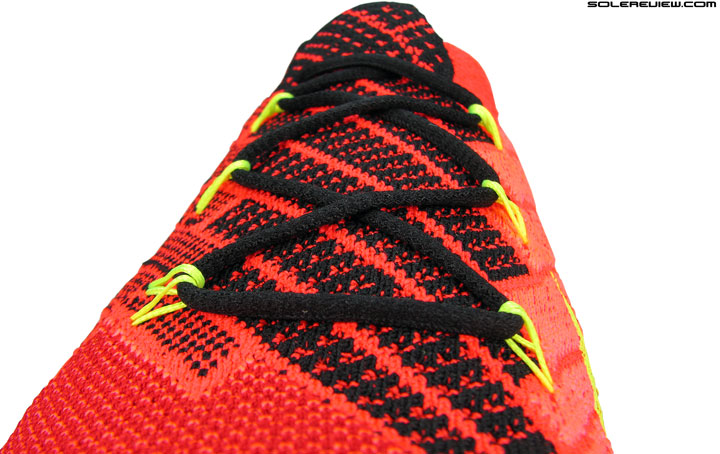
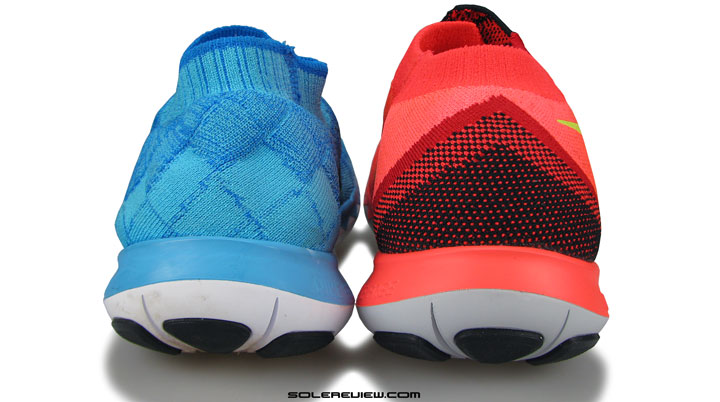
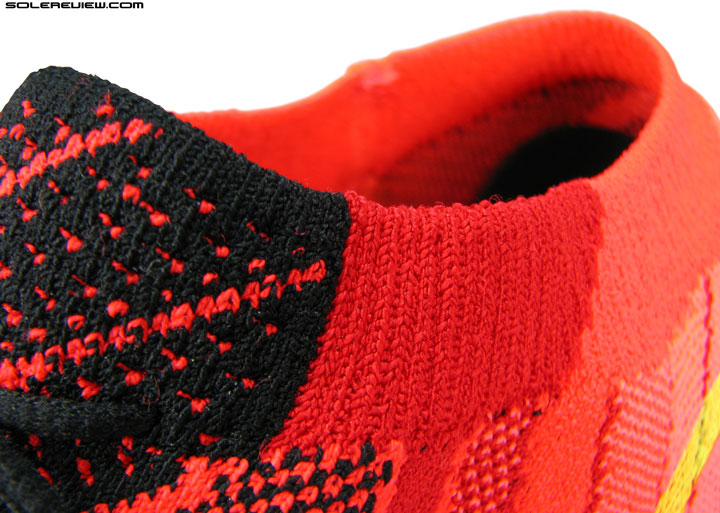
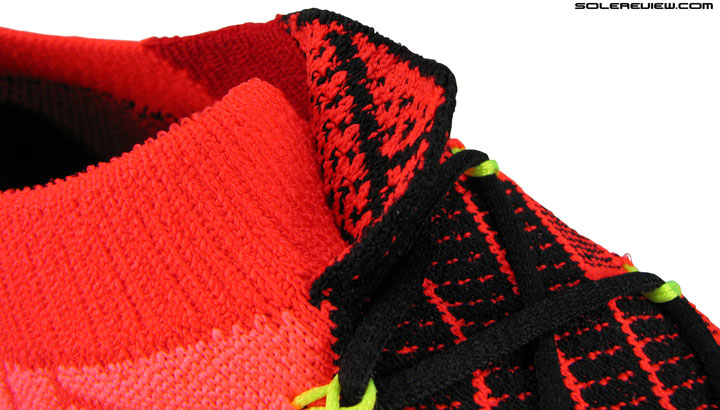
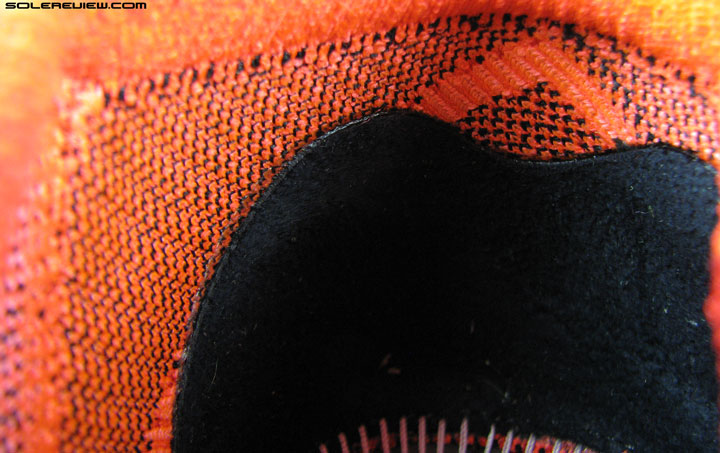
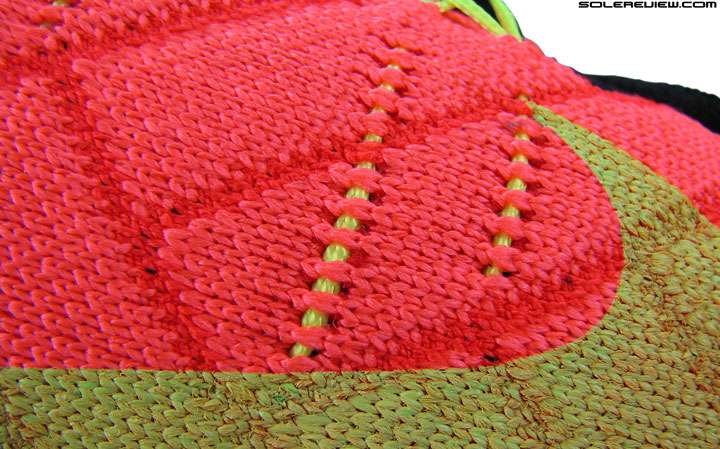
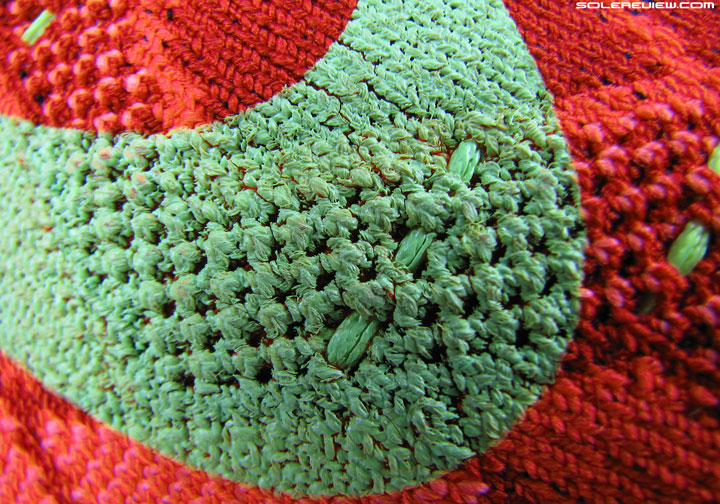
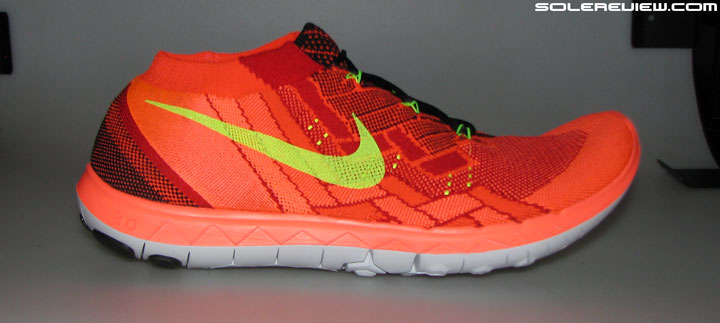
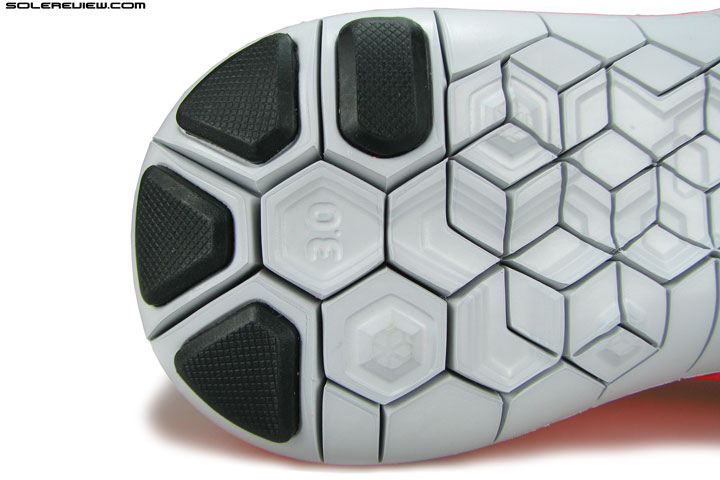
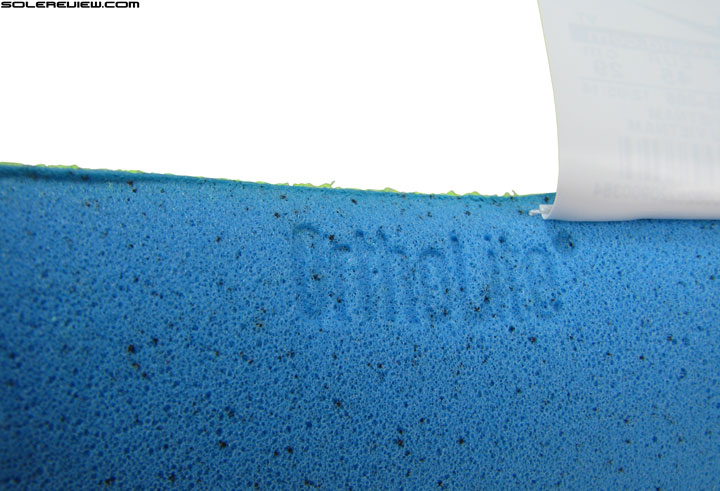
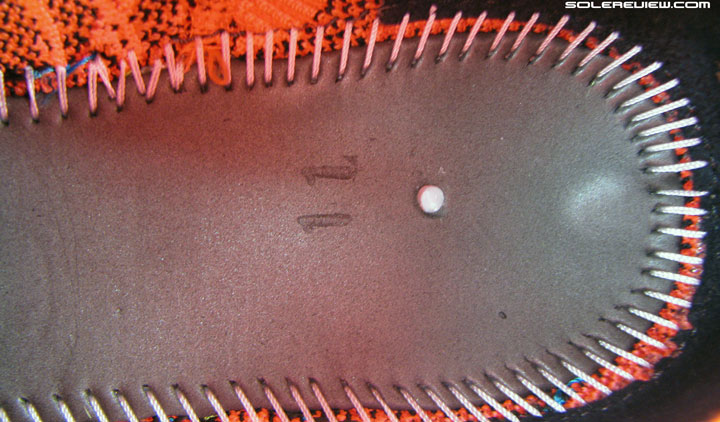
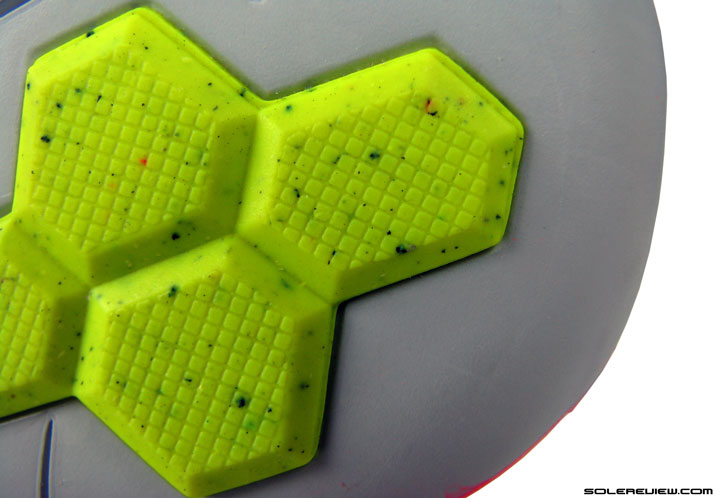
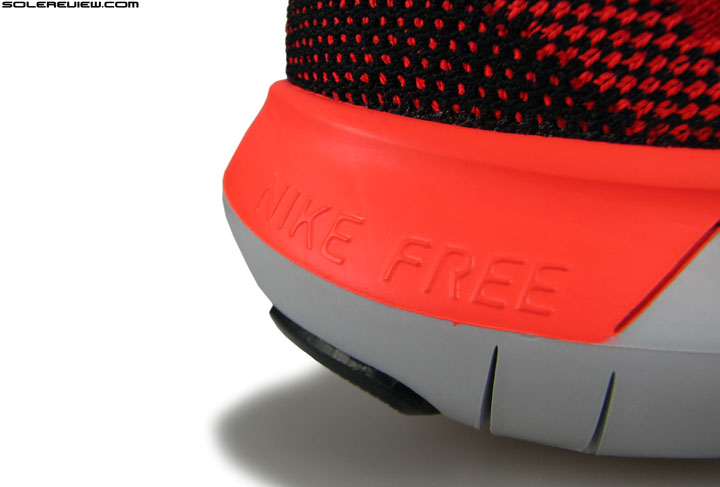
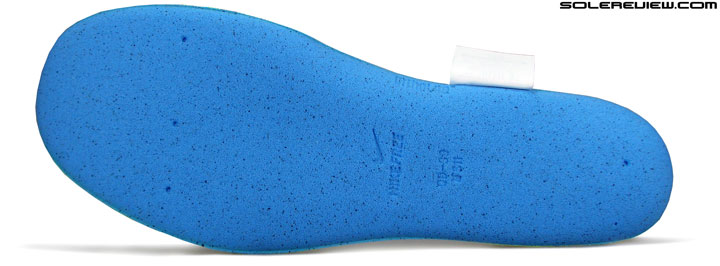
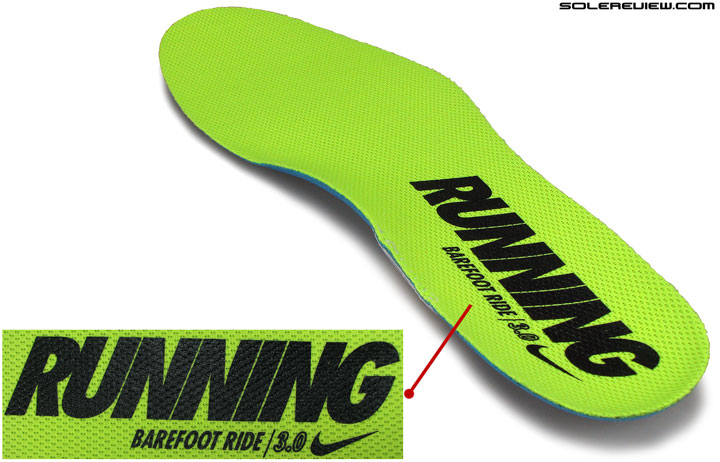
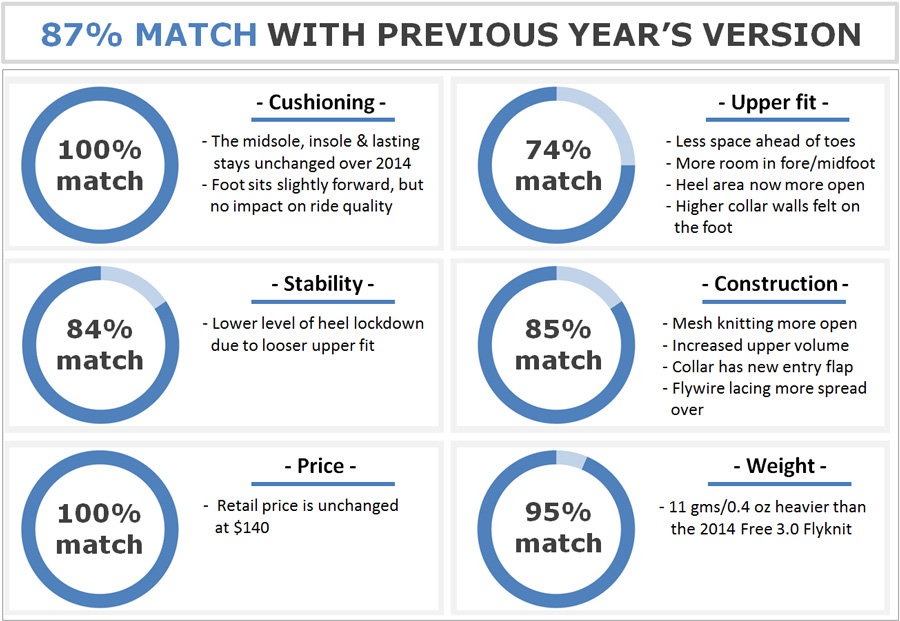
32 comments
Huge fan of the 2014 version of this shoe and unlike many other users had no issue with the snugness of the fit. The 2015 version, handsome though it may be, seems to be too loose. I downsized by half a size to get the midfoot to fit, then realized the toe space was lacking. I didn’t buy it in the end but when it goes on sale I’ll still probably give it a go.
One thing i don’t think you mentioned– the Free flyknit 3.0 (and I assume the 4.0 by extension) is great for frequent travelers who are runners as it packs nearly flat due to the unstructured upper. This was my experience with the 2014 version and it probably holds for the 2015 version too.
Thank you for the feedback, we also share the same read on the 3.0 – short on toe space but a bit loose in the back.
Yes, both these shoes are great for ’travelling’ running shoes! Coming to think of it, the Free is also our go to carry-on/check-in shoe :)
Hi,
Here’s a general question about wear–maybe on topic since the frees don’t have much rubber. What is your opinion on outsole wear? It seems to me that most shoes wear out on their outsoles before the midsoles really lose cushioning. Aside from losing grip/traction does it really matter? That is, with all of our attention to “drop” and mm, it seems pretty easy to wear down a few mm of rubber on traditional running shoes. Does it affect foot strike? If it doesn’t, it seems you can go pretty far on each pair of shoes before replacing them, or use less rubber based shoes like the frees.
Unless the shoe is really flimsy or fast wearing (adidas Ultra Boost), most outsole compounds – including Nike Free – last for at least 400 miles before it has any impact on the quality of the ride.
To put ‘quality’ in specific terms, it might mean that the shoe might not feel as efficient (as before) in cushioning/stability/grip/transition. The worse case scenario is that excessive wear might result in soreness/pains not experienced in the shoe’s early-mid life.
But for most runners, outsole wear is not a cause of worry – because the shredding happens so gradually, the body adapts to the new geometry. That is why some people have problems adjusting to a brand new shoe after they’ve had 600 miles on the old one.
Bottomline – unless the shoe starts becoming uncomfortable or less efficient in its function or structurally damaged, there is no reason to replace your shoes.
Excellent information, thanks!
“However, the extremely beveled design of the midsole makes the 3.0 less stable than both the Free 3.0 and 5.0.”
Weren’t you going to say less stable than both the Free 4.0 and 5.0?
Yes, corrected! Thank you! Admittedly, proof reading is the hardest part of writing – and this after the Free 3.0 Flyknit was proofread at least a dozen times. Arrgh.
Hi,
I’m a former rower who’s recently taken up running. 6′ tall, 190lbs, neutral forefoot striker. So far my biggest issue is that my lower legs can’t keep up with my ‘engine,’ so to speak. Shin splints pop up on the regular. I’m starting off with thrice-weekly 2-to-3-milers, depending on how I feel. Hoping to build up to regular 6-milers.
While I rowed, I occasionally cross-trained in Boost Supernova Glide 6, but they ticked off my PF something nasty. I loved the responsiveness, though.
Then I tried the Glycerin 13s but they felt plodding. Took them back. No bueno.
I recently picked up the new Flyknit Free 4.0s (after a shootout with the 3.0s), which are almost perfect (love the barefoot feel), but a little squishier than I’d like. I’d like to hear your opinion on a good shoe to rotate with the 4.0s. My dream shoe is 4.0s with Boost, but some things aren’t meant to be.
Thanks!
Anders
What exactly do you want your second pair to do? A place between the Glycerin 13 and the Free 4.0? Some feedback would help us recommend a pair or two.
I guess the best way of putting it is I need a neutral, forefoot-strike-friendly workhorse that’s neither the Glycerin 13, Supernova Glide 6, nor Vomero 10 (which I’ve since tried) and also provides a ground feel similar to the Free 4.0.
Sorry if I sound inconsistent. I’ve yet to fully figure out what I’m talking about.
Nike Zoom Streak LT 2
Can only think of the Brooks PureConnect 4. Delivers ground feel, but with more cushioning than the Free 4.0.
Ricdeau (below) has mentioned the Streak LT 2. It is minimal and has a snappy feel to it, but less cushioned.
Hi how do these compare to the Nike free 3.0 v4? I love the flexibility of those shoes (I have high arches and stiff toe joints and I honk a flexible shoe helps me?) but they need replacing. I was considering the flyknit 3.0 or 4.0 and sounds like overall the latter is perhaps the better shoe but how different are they to the old 3.0 v4? Thanks
They fit and feel quite differently from the Free 3.0 V4. In the sense that the midsole ride does not have the planted feel of the V4, and the Flyknit upper pressure is higher.
A better option here is the Nike Free 4.0 (not the Flyknit), which should feel similar to the older 3.0 V4
Thanks for the advice. In the end I tried the free 4.0 fly knit and have been impressed so far. Even after short runs around 5 miles I was getting soreness in both calves at the top of the Achilles’ tendon. Not getting that at all in the free 4.0s on the same run route. Great site by the way… Keep up the good work!
Appreciate the feedback, Simon. Thank you for sharing!
Hi, I would like to buy a shoe. My choices are Flyknit 4.0, Adidas Boston Adizero Boost, or Adidas Ultra Boost. I have run with Vivobarefoot shoes previously. Its minimilist shoes which greatly improved my running style. But recently when I am trying to exceed certain speed, I am feel pain in my toes. I run usually 10km marathon only. My main aim always has been on the timing. I would really appreciate if you can tell me which shoe do you recommend?
Thank you very much!
Out of the three, the adidas Boston Boost is the shoe you should try.
Thank you very for fast reply..I was about to buy yesterday but I thought I could just wait for your response. :).Thanks once again
You’re welcome. If you prefer more room inside the shoe, the Free 4.0 Flyknit is also worth a try.
Avoid the Ultra Boost, however.
Great! Yes I was also looking for more toe area which flyknit has it.. since i have been running in similar shoe. But my only feeling is if it has upper cut limit in speed at which I could propel myself. Or maybe I should give a try :)……
just one more last question..do you have experience if there is going to difference in the timing.
95% of that depends on you. But as a shoe, the Boston feels faster than the 4.0 due to its stiffer forefoot.
Thank you very much for the help. I will give try both and let you know…
Just stumbled across this site and so glad I did–you do a terrific job! Looking for some advice on models to consider given some tricky constraints. I’ve transitioned to zero drop shoes (first with the Merrell Ascend Glove, which proved to be too narrow in the forefoot, and more recently with the Vivobarefoot Evo Pure, which has proven to have inadequate cushion) and really want to stick with a drop as low as possible. But i have Tailor’s bunions on both feet and one has been severely aggravated by the complete lack of cushion in the Evo Pures. So, I’m looking for a very low drop shoe with extra width in the forefoot, lots of cushioning, low weight and preferably with a low enough profile so that the material doesn’t touch my ankles. Any ideas I should consider? Thanks!
The Skechers Gorun Ride or GoRun Ultra Road might just be your shoes – forefoot room+cushion+low drop.
Thanks–those both look like good options. How about the Flyknit 4.0 in wide (ID version)? It’s a 6mm drop vs 4mm for the Skechers but I believe might be roomier. Believe might be similar cushion but can’t seem to find relative cushion levels. Thanks again!
You’ll get plenty of room on the wide Flyknit 4.0, but not plenty of cushioning. The Skechers will run more padded than the Free Flyknit. But then, it depends on your relative definition of cushioning.
The comments/Q&A thread will be closed till January 17, 2016. Any inconvenience is regretted. Premium access members can use their dedicated comment section, which will be open.
I wear a size 10. Do they fit true to size? I found the shoes a half size down on sale and was wondering if it would be ok. Or would 9.5 run to tight or small?
A 9.5 would be too tight. In our opinion, you should get a half size larger over your regular size (10.5).
Comments are closed.